Op Ed: The Education of an Environmental Educator
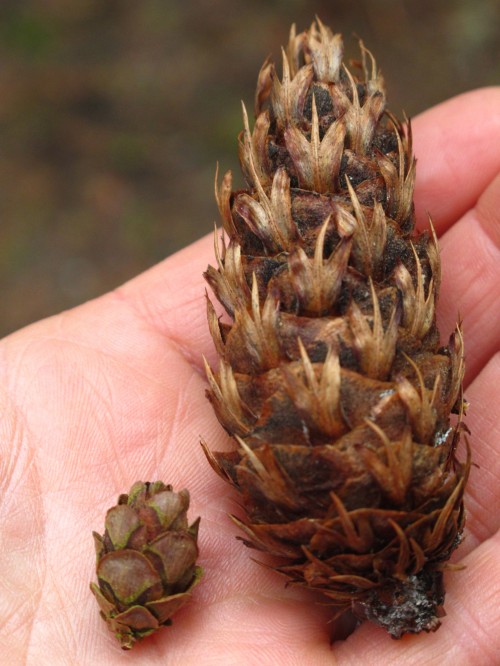
Editor’s note: Mountain School is about to start back up for its fall season! After teaching two seasons and hundreds of students last year, I thought a lot about how the field of environmental education might be even more useful to participants and the world at large.
It was quite an event, the day the Great Spirit handed out cones to all the trees in the forest. Red alder was given a tiny bouquet of them, befitting its important role as a quick and efficient pioneer in new forests as a nitrogen-fixing species. Douglas fir was bestowed with robust, two-inch long ones. They were decorated with characteristic “mouse tails”, like celebratory ribbons trailing between each thumbnail-sized scale. They provided a main source of food for the squirrels that scampered through the forest. Western hemlock, however, was impatient and pushed its way to the front of the line, eager for the best cones. As punishment for hemlock’s haste, the Great Spirit gave it the smallest cones in the forest. Feeling forever badly about being chastised, hemlock hung its head in shame.
Though I am unsure of this story’s origins, it has undoubtedly evolved over the years as a tale that environmental educators in the Pacific Northwest often share. It is a way to remember, amidst all the trees in the dense forest, that Western hemlocks are the ones possessing small cones and a drooping leader.
Here is another version, adapted from a re-vamping by graduate student and co-editor of Chattermarks, Elissa Kobrin. Her story is different, but still told with the goal of leaving learners with the ability to distinguish common local trees. It begins similarly, with red alder and Douglas fir receiving their cones. Both trees wanted to be the first ones in the forest, and to shoot up toward the sky faster than all the others. Western hemlock, however, waited patiently in line. This patience represents hemlock’s role in the forest community as one of the last species in forest succession, for it thrives in the shade of the canopy other, faster growing species. Hemlock was given cones that, though comparatively small, are very ornate and beautiful, like the rosebuds of the forest. Its head, or “leader”, is always bent over to get a better look at its tiny, pretty cones.
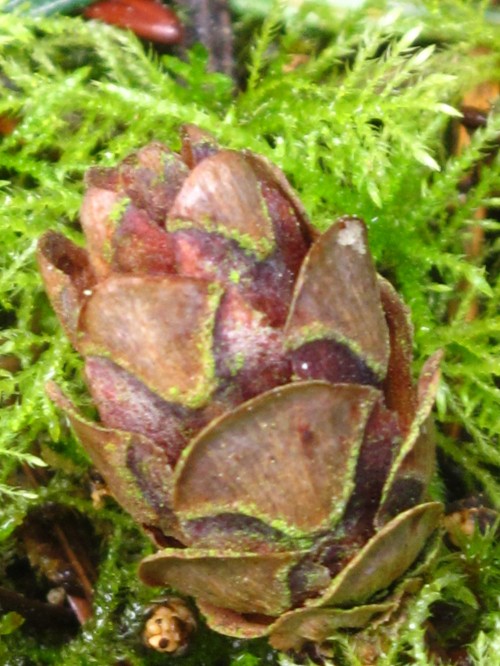 A macro rendition of the 3/4″ tall hemlock cone, at home amidst the miniature world in a bed of moss. Note the chartreuse pollen that settled in the scales, details that make the natural world go round. Photo by author.
A macro rendition of the 3/4″ tall hemlock cone, at home amidst the miniature world in a bed of moss. Note the chartreuse pollen that settled in the scales, details that make the natural world go round. Photo by author.
Which story do you prefer? When I first heard the former, I immediately thought, “Wow, I will never tell this story to students.” Was I just being overly sensitive, another stringently politically correct tree-hugger quibbling over words? In one sense, the first story is simply an engaging way to remember why a hemlock has a drooping leader and small cones. But in the context of a world where shame and bullying are rampant, and shadow who children become as adults, could it also serve, even in a slight way, to perpetuate the idea of lifelong self-denigration and insecurity? That small is bad, and we are expected to atone for our mistakes for the entirety of our lives?
Such reservations are not to advocate for sheltering our children from reality. We graduate students-slash-Mountain School instructors often discuss, with a lot of concern, the tendency over the last 30 years or so towards “protecting” children from anything deemed negative or risky in this world of unknowns. Even something as intrinsic as play, for example, has been made scary and restricted.
Yet as an editor who has been steeped in media criticism, it is hard to ignore the messaging we’re bombarded with from all directions, even from stories told in the woods. Reinforcing ideologies and paradigms that I consider part of the problem, especially in an ecologically-minded community in which we’re constantly emphasizing the interconnectivity of everything, is problematic. Words are powerful. Looking at all the way we teach kids, both explicitly and implicitly, is fundamental.
Admittedly, it is a little hard for me to write this. I really don’t want to seem uptight, and such reservations prompt me to feel a mite self-conscious and embarrassed. At the same time, though, it baffles me that we are not more self-critical sometimes.
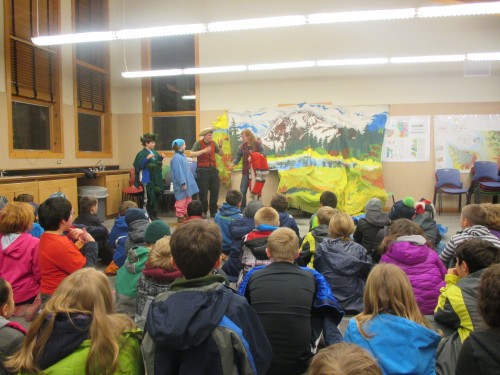 A fifth grade Mountain School group is an engaged audience as instructors help them “travel back in time” to when Native Americans gathered Hozomeen chert, cured skin ailments with Douglas fir pitch and traveled through the North Cascades via Cascade Pass. Photo by Molly Foote.
A fifth grade Mountain School group is an engaged audience as instructors help them “travel back in time” to when Native Americans gathered Hozomeen chert, cured skin ailments with Douglas fir pitch and traveled through the North Cascades via Cascade Pass. Photo by Molly Foote.
Another instance at Mountain School that always prompts me to keep my mouth closed is the song “Baby Shark”. The plot line? There is a family of sharks, the inevitable shark attack, and then, in a nice ecological full circle, decomposition and the attackee returning as a baby shark. Simple, catchy, energetic. A melodic rendition of the cycle of life. Who can argue with a spirited campfire sing-along?
Zoom out from the campfire. In the context of the brutal shark finning industry in which millions of sharks have their fins cut off and are thrown overboard, alive, to slowly die in the name of a delicacy for the wealthiest of the wealthy, is demonizing these apex predators an attitude we really want to promote? Combine this with a hysterical media that has nearly one hundred percent solidified our fear of sharks (remember Jaws?), and this ancient group of fish has little chance of easy survival. Sure it’s just a song for fifth graders, but sharks need all the love they can get right now.
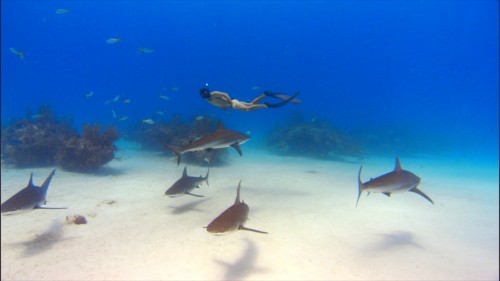 An image from Rob Stewart’s film, Sharkwater (2007). The expert diver and underwater photographer’s documentary does a beautiful and powerful job of challenging popular misconceptions about sharks and battling global shark poachers. Photo by Rob Stewart.
An image from Rob Stewart’s film, Sharkwater (2007). The expert diver and underwater photographer’s documentary does a beautiful and powerful job of challenging popular misconceptions about sharks and battling global shark poachers. Photo by Rob Stewart.
Some words and portrayals may bother one person but not another. This is not new news. We all come to a community with varied backgrounds and perspectives. This is called diversity, and we’re encouraged to respect it, cultivate it and like it. Me, I’m driven crazy when Native Americans’ presence in the landscape is referred to in the past tense. Or when characteristics of carnivores, such as their sharp canines, are referred to as “ferocious” and “mean,” considering they are one of the most critically endangered orders of animals due to centuries-long campaigns against their kind. Others are frustrated by the unexamined, insistent use of gendered pronouns, or cringe at “chick” or “dude.” We all have our triggers, our battles, our righteousness and our wrongness, too.
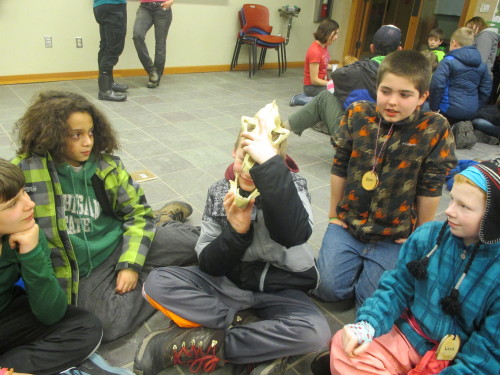 How do we talk about carnivores with students? How does this inform their opinion, or how they might vote as adults? Photo by Molly Foote.
How do we talk about carnivores with students? How does this inform their opinion, or how they might vote as adults? Photo by Molly Foote.
I will choose to tell the “rosebud” version of how hemlock got its cones, and will rave to the students about how sharks, wolverines, spiders, bees and snakes are pretty much the awesomest creatures ever. I will wonder if my careful word choice makes any difference, makes someone think differently for one illuminating moment or grow up into an adult human who’s a little more open-minded and less fearful of things that are different from them.
It is easy to assume that as an environmental educator, you’re automatically contributing to the good, on the side of saving the world. There is truth in this and also, like any job, an opportunity to constantly refine and be better. Sitting on the shores of Diablo Lake, it’s time channel our surrounding peaks rising from the blue-green water. Reflect.
Katherine Renz is a graduate student in North Cascades Institute and Western Washington University’s M.Ed. program. Someday she hopes to write a whole series of children’s books populated by animals that are undeservedly demonized in popular culture. Wanna help?


Hemlock could also be compared to the “omega” wolf of the pack. This could lead into trophic cascades and the role of predators generally, as Cristina Eisenberg tells it in her The Wolf’s Tooth. Or the other way back, if they’re already into wolves, but you need a lead into trees ?
PC with kids is variable with where they’re from, in my experience. I try to interact with their teachers, to try and get a handle on their cultural backgrounds. I’m sure that PC is important for how we come across. The wrong buzzword can easily block off those little ears. -EB,Mazama
Hi Eric — Yes! 100% agreed. Thanks for reading, and for taking the time to comment, too.